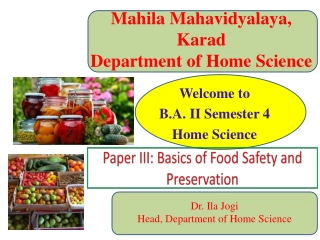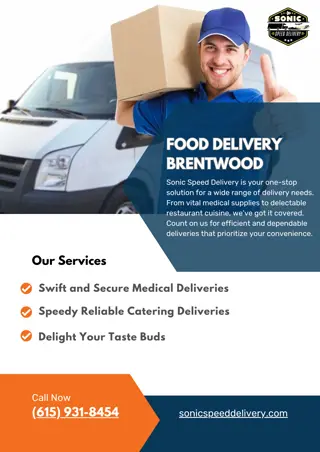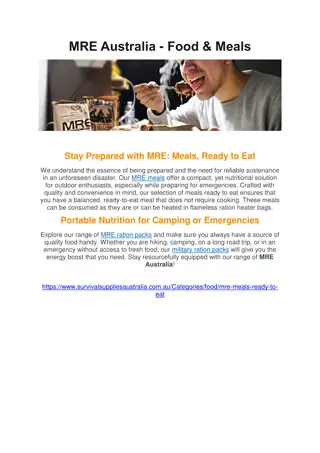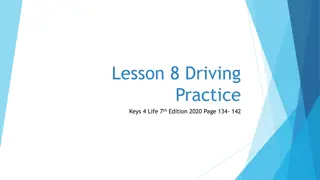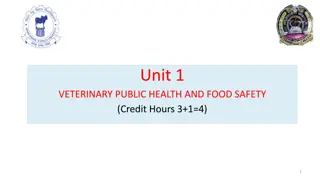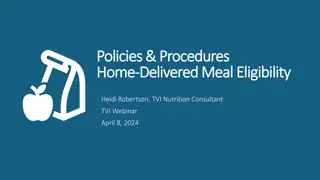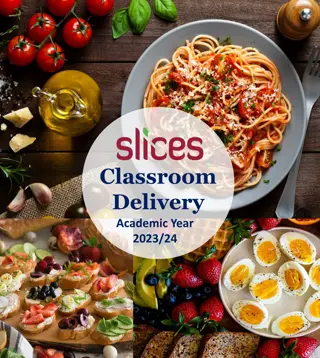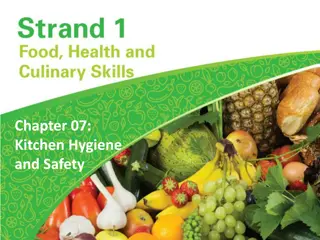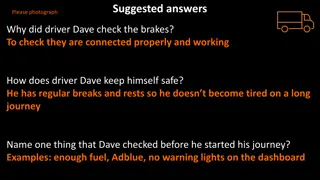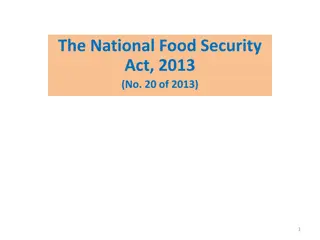Food Safety Guide for Delivery Drivers of Home-Delivered Meals
This guide emphasizes the importance of food safety for delivery drivers handling home-delivered meals, particularly for vulnerable populations. It covers topics such as temperature control, safe food handling practices, and packaging guidelines to ensure the meals remain safe for consumption. Adherence to these guidelines helps prevent foodborne illnesses and maintains the quality of delivered meals.
Download Presentation

Please find below an Image/Link to download the presentation.
The content on the website is provided AS IS for your information and personal use only. It may not be sold, licensed, or shared on other websites without obtaining consent from the author. Download presentation by click this link. If you encounter any issues during the download, it is possible that the publisher has removed the file from their server.
E N D
Presentation Transcript
FROM THE KITCHEN TO THE TABLE A food safety guide for delivery drivers of home delivered meals Updated 11-16
Foodservice Operation Community programs Elderly Nutrition Program, MOW Considered Food Establishments (1-201.10) FDA writes Federal Food Code States adopt, adapt or write own Older Americans Act Administration on Aging writes federal guidelines states write own state policies. AAAs and counties may have own local policies in addition Delivery drivers are still foodservice workers and must follow the rules of the food code
Highly susceptible population Provisions in Food Code specifically for: The Elderly immune systems weaken with age The very young haven t built up immunity yet Pregnant women compromised immune systems Immuno-compromised Cancer / chemotherapy HIV / AIDS Transplant patients No undercooked food, bare hand contact, raw seed sprouts
Temperature Danger Zone 41 F - 140 F This is where most bacteria grow! Protein foods are hard to get to hold temp, so put out small batches and be sure food is hot before packing. Gravies and sauces can help retain temperature.
Keeping food safe Potentially hazardous food must be kept out of the temperature danger zone (TDZ) or in TDZ for LEAST amount of time possible 3-501.16: Potentially hazardous food shall be maintained at 140 F or above; or 41 F or less until served You MUST ensure that your thermometer is accurate and calibrated regularly
Before you start dishing up food: 1. Use common sense 2. Ensure your clothes are clean 3. Put on your hair restraint 4. Wash your hands 5. Put on your gloves 6. Check food temps 7. Ensure utensils, equipment and containers are clean and free of debris 8. Only dish up meals a few at a time
Packaging Meals Avoid time / temperature abuse Package small amounts at a time 1-10 trays at a time Want assembly line Keep foods safe until in packaging Cover and seal immediately Example of what NOT to do: 40 meal trays spread out on the counter Dish vegetables. Then starches. Then meat. Then cover and seal.
Cold Food Packaging All cold food and beverages should be packed in coolers that maintain the food below 41 F Use ice or gel packs, or coolers that plug in to outlets or jacks to maintain the temperature. Foods must be kept at a safe temperature during delivery Frozen foods must be maintained frozen solid
Hot Food Packaging Transported separately from cold foods Transported in a carrier that maintains the temperature above 140 F All should have lids and a heating device such as a heat stone, heated gel pack, plug-in heater or transport bag, for example Cambro, Nutrisystem bags or other thermal transport containers
Quality It is important that transport carriers protect meal packages from contamination, crushing or spillage to assure a high quality, appetizing meal is served When packing meals into bags, coolers or carriers, ensure that they re not packed too high, that they don t move around too much and the carrier can be closed.
The Pick Up Location Your local program will instruct you on the specifics for location time and address to pick up the home delivered meals. There will be a hot bag and a cold bag or cooler for your route. There is usually a clip board or route sheet with detailed information. This will all be explained locally.
What Types of Meals are Served? This varies on your location. Some offer only a general diet, others have specialty diets Some also offer frozen meals These need to stay in a solid frozen state during delivery so be sure to have ice packs and use appropriate equipment. Check to see if the participant would like you to put the frozen meals directly into their freezer. Observe if the meals are starting to stock pile and inform your site manager. Ask if they have any problem reheating the meals
The Route Sheet Usually contains the following information: Who do I deliver to? How do I get there? What food do I give them? Is there anything special I need to know about delivering to a specific participant? How does the office know if and when I delivered a meal?
Preparation Be sure your delivery equipment is clean and sanitized If you have electrical equipment for holding the food at a hot or cold temperature be sure it is working properly Be sure to keep the cold food in your air conditioned vehicle when it is hot out to avoid overheating in the trunk
Thermodynamics Second law of thermodynamics: The entropy of any closed system not in thermal equilibrium almost always increases. Closed systems spontaneously evolve towards thermal equilibrium -- the state of maximum entropy of the system in a process known as thermalization. Uh .WHAT?!? WHAT?!? Means this: if all components of a system are not the same temperature, ultimately the hottest part will lose heat energy until it all reaches the same (lower) temperature
Heat Transfer When an object is at a different temperature from another body or its surroundings, heat flows so that the body and the surroundings reach the same temperature, at which point they are in thermal equilibrium. (Wikipedia) Conduction bodies touching (food touching a container) Convection gas or liquid (air stealing the temp) Who cares?! Who cares?!
Why heat transfer matters: Hot food into a cold container lose heat Hot food into a cold trunk lose heat Cold food into a hot trunk heats up Cold food placed into a room-temp (or warm) container heats up Food is highly affected by the temperature that surrounds it
In The Car Is the TEMPERATURE of the food protected? Front seat or trunk? SUV or car with actual trunk? What s the outside temp? What s the temp inside the vehicle? How long is the route? What are your test trays and data showing?
In The Car, continued Is the QUALITY of the food protected? Food containers secured? Protected from spillage? Protected from disruption bumpy roads, poor driving, loose objects in car, etc. Can anything fall on or crush food? Are the drivers keeping the bags and containers separated (versus stacking crushing)?
In The Car, cont. Is the SANITATION of the food protected? Are all containers closed and safe from contamination? Is there old mail or papers, fast food containers and bags, snack bags, old grocery bags? Are there any animals in the car? Pests i.e. flies, fleas and ticks, spiders, mice? Cleaners, lubricants, solvents, other chemicals around? Rusty objects, tools, spare tires, etc.?
Personal Hygiene Don t smoke while delivering meals. Cover all cuts, open sores or wounds with a waterproof bandage PLUS a glove or other barrier. Wear gloves during any and all food preparation Wear clean clothes, clean hats Delivery drivers are still foodservice workers and must follow the rules of the food code
THE LAW: Food Code says: 2-403.11: Food employees may not care for or handle animals that may be present such as patrol dogs, service animals, or pets Unless they are your service animal, in which case you need to wash hands as outlined in the food code prior to returning to work Go to fullsize image
What about drivers hands? Avoid petting animals. If you do touch an animal wash your hands! If assistance is required (i.e. opening milk carton) WASH HANDS THOROUGHLY prior to touching any food-contact surface consider using a fork instead of your hands to open the container. Hand Sanitizers - be sure to have some in your vehicle and use it often! Any time you have touched something in someone s home don t take that to the next person
During the delivery... Open and close the delivery bags as quickly as possible to avoid temperature loss If walking a distance with the meal, carry it in the insulated bag In hot weather keep the cold food in the air conditioned interior of your car when possible Same goes for cold weather keep hot food in the heated part of the vehicle
Care of transport bags Bag must be kept INSIDE vehicle when delivering meals Unplug bag carefully after delivery of last meal and tuck cord in bag Disconnect the bag from the vehicle outlet when the vehicle engine is off for extended periods of time (greater than 30 min.) Never crush or fold bag Do not submerge bag in water If any bag cords become loose, cracked or frayed, stop using immediately
Leaving food Never leave food on doorstep, in garage, in parked car, etc. Time / temperature abuse Contamination Tampering Liability Loss / theft
Food Safety Check (1) Remind participants to put the meal in the refrigerator if they are not going to eat it right away and to put leftovers in the refrigerator immediately Food safety handouts and training for customers
Food Safety Check (2) Refrigerator magnet or handout with storing and re-heating instructions (ex. use within 3 days , or refrigerate any unused leftovers ) Date all packages before delivering Provide menu to all participants so they and family members can monitor how old the food is
Food Safety Check (3) Ask how they reheat the meals and if the microwave or oven works properly and if they need assistance operating them Food to be heated in the microwave should be placed in a microwave safe container, not heated in aluminum or plastic containers Remind clients to frequently stir food reheated in a microwave to ensure even heating
Temperature Monitoring When At least once a quarter (once a month if routes are longer than 1 hour) you will be asked to check the temperature of a test tray after you deliver the last meal on your route. What Test all food and the milk and record on the form provided. Please also note the quality of the food and how it looks/tastes/smells. How Insert thermometer probe into the food until the dimple on the stem is covered. Wait until the dial stops and then record the temp. Clean & sanitize the probe with alcohol wipe between each test.
Monitoring for food safety A test tray should be sent regularly to check the temperature of the food at the end of the meal delivery route Evaluate the data (don t ignore the data!) Trends Temps Quality Customer satisfaction scores Go to fullsize image
Corrective Action Plan If hot food is below 140 or if cold food is above 41 degrees we need to determine why. Check thermometer to be sure it is calibrated and also check equipment to be sure operating correctly. Be sure you are using a hot and cold source to keep the food out of the danger zone. Minimize how long the bag is open. Keep the cold food in the air conditioning and not in the trunk in the summer. Keep the hot food in the car, not in the trunk in the winter. Discuss with your site manager and then recheck the temps in a week or so to see if they improve after changes have been made.
What else you may deliver Monthly menus- encourage them to hang on their fridge Nutrition Education handouts Nutrition Surveys Donation Statements Special announcements Others as needed
THANK YOU FOR DELIVERING MEALS! Our program couldn t operate with outstanding individuals such as yourself that give of their time and energy. Sincerely, thank you!







